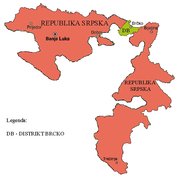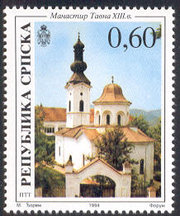Republika Srpska
|
|
| |||||
| Missing image Republika_srpska1.png Republika Srpska shaded red | |||||
| Official languages | Serbian, Croatian, Bosniak | ||||
| Capital | de jure Sarajevo, de facto Banja Luka | ||||
| Area – Total – % water | 24,811 km² n/a | ||||
| Population – Total (2001) – Density | 1,490,993 60/km² | ||||
| Ethnic groups (1996) | Serbs: 90% Bosniaks: 7% Others: 3% | ||||
| President | Dragan Čavić | ||||
| Prime minister | Pero Bukejlović | ||||
| Anthem | Bože Pravde (God the Righteous) | ||||
| Time zone | UTC +1 | ||||
| Currency | Convertible Mark (KM) | ||||
The Republika Srpska (RS) is one of the two political entities that compose the state of Bosnia and Herzegovina (the other entity is the Federation of Bosnia and Herzegovina).
| Contents |
Name
Republika Srpska is primarily inhabited by Serbs. In English it is sometimes called the Serb Republic or Republic of Srpska, although the latter is an incorrect translation ("Srpska" is an adjective, not a noun). Because of the potential for confusion between the "Serb Republic" (Republika Srpska) and the "Republic of Serbia" (Republika Srbija), the name "Republika Srpska" is often used in its untranslated form in non-Slavic countries to avoid any confusion with The Republic of Serbia. This article follows that convention.
History
Origins
For the origins and early history of Serbs in the territory of today's Republika Srpska, see History of the Serbs.
Also see: Vrbaska banovina, History of Bosnia and Herzegovina and Bosanska Krajina.
Creation of Republika Srpska
During the political crisis that followed the secession of Slovenia and Croatia from the former Socialist Federal Republic of Yugoslavia on June 25, 1991, a separate Bosnian Serb Assembly was founded on October 24, 1991, as the representative body of Serbs in Bosnia and Herzegovina.
A plebiscite was held on November 9 and 10, 1991, that asked citizens whether they want to remain within Yugoslavia. The parliamentary government of Bosnia and Herzegovina asserted that this plebiscite was illegal, but the Bosnian Serb Assembly acknowledged its results. On November 21, 1991, the Assembly proclaimed that all those municipalities, local communities, and populated places in which over 50% of the people of Serbian nationality had voted, as well as those places where citizens of other nationalities had expressed themselves in favour of remaining in a joint Yugoslav state, would be territory of the federal Yugoslav state.
On January 9, 1992, the Bosnian Serb Assembly adopted a declaration on the Proclamation of the Serbian Republic of Bosnia and Herzegovina (Republika Srpska Bosne i Hercegovine). On February 28, 1992, the constitution of the Serbian Republic of Bosnia and Herzegovina declared that the state's territory included Serb autonomous regions, municipalities, and other Serbian ethnic entities in Bosnia and Herzegovina (including regions described as "places in which the Serbian people remained in the minority due to the genocide conducted against them during World War II"), and it was declared to be a part of the federal Yugoslav state.
From February 29 to March 2, 1992, Bosnia and Herzegovina held a referendum on independence. The majority of Bosnian Serbs boycotted the vote on the grounds that it was unconstitutional because the referendum bypassed the veto power of the representatives of the Serbian people in the Bosnian parliament. On April 6, 1992, the European Community formally recognised the independence of Bosnia and Herzegovina. The Serbian Republic of Bosnia and Herzegovina declared its independence on April 7, 1992. On August 12, 1992, the reference to Bosnia and Herzegovina was dropped from the name, and it became simply Republika Srpska.
War in Bosnia
The Bosnian Serb Army evolved from Bosnian Serb officers and soldiers of Yugoslav People's Army, maintained and expanded the borders of Republika Srpska during the 1992-1995 war in Bosnia.
On May 12, 1992, at a session of the Bosnian Serb Assembly, Radovan Karadzic announced the six "strategic objectives" of the Serbian people in Bosnia and Herzegovina:
- Establish state borders separating the Serbian people from the other two ethnic communities.
- Set up a corridor between Semberija and Krajina.
- Establish a corridor in the Drina river valley, that is, eliminate the Drina as a border separating Serbian states.
- Establish a border on the Una and Neretva rivers.
- Divide the city of Sarajevo into Serbian and Muslim parts and establish effective state authorities in both parts.
- Ensure access to the sea for Republika Srpska.
At the same session, the Bosnian Serb Assembly voted to create the Vojska Republike Srpske (VRS) (Army of the Republika Srpska), and appointed Ratko Mladic, the commander of the Second Military District of the Yugoslav federal army, as commander of the VRS Main Staff. At the end of May 1992, after the withdrawal of Yugoslav forces from Bosnia and Herzegovina, the Second Military District was essentially transformed into the Main Staff of the VRS. The new army immediately set out to achieve by military means the six "strategic objectives" of the Serbian people in Bosnia and Herzegovina (the goals of which were reaffirmed by an operational directive issued by General Mladic on November 19, 1992).
Various allegations have been made with regard to the nature of the Serb Republic with respect to the amount of ethnic cleansing and other war crimes committed against non-Serbs in territory controlled by the Republika Srpska and its military forces. So far, the authorities of Republika Srpska have only admitted to two massacres: the Vlasic massacre of 90 Bosniak civilians in 1992 and the 1995 massacre of 5-8,000 Bosniaks at Srebrenica. Both its founding President and war-time military leader Radovan Karadzic and Ratko Mladic are sought by the Hague Tribunal but some of those responsible for concentration camps (not to be confused with Nazi-style extermination camps) at Omarska, Trnopolje and Manjaca remain in positions of local authority. To some, the name and insignia of Republika Srpska are inherently intolerant towards other Bosnians and evoke very negative connotations of war-time problems for them.
Legitimacy

The legal existence of Republika Srpska was postulated by the Agreed Basic Principles issued on September 8, 1995, and the Further Agreed Basic Principles issued on September 26, 1995, and was confirmed by the Dayton Peace Agreement, although Republika Srpska has never received international recognition as a state. (Under an agreement on August 29, 1995, a unified delegation composed of three delegates of the Federal Republic of Yugoslavia and three delegates of Republika Srpska — led by former Yugoslav president Slobodan Milošević — was authorized to negotiate and sign the Dayton Peace Agreement on behalf of the Republika Srpska.)
Republika Srpska was not created by the Dayton Peace Agreement; indeed, Republika Srpska was a party to several of the annexes to the General Framework Agreement. Republika Srpska has maintained its territorial and legal continuity since it was proclaimed on January 9, 1992, and the constitution adopted in 1992 (as amended) remains in force to this day.
A revision or withdrawal of the Dayton Agreement would not cause a discontinuation of Republika Srpska (nor a number of other changes in the political makeup of Bosnia and Herzegovina possibly required to make the government more straightforward), only a democratic consensus.
Politics
The RS has its own government, coat of arms, anthem, president, parliament (the Народна Скупштина Републике Српске/Narodna Skupština Republike Srpske), customs department, postal system, and airline (Air Srpska).
Republika Srpska also has its own entity police force and a standing army (Vojska Republike Srpske ). In late 2004 negotiations begun on integrating the police systems of both entities, including the transfer of the administration from the entity ministries to a new state-level Ministry of Security. Negotiations to place the armies of both entities under the control of a new state-level Ministry of Defence also begun in autumn of 2004.
RSDinar.jpg
From 1992-94 RS had its own currency, the Republika Srpska dinar, but now uses the convertible mark along with the rest of Bosnia-Herzegovina. It uses the Serbian tricolour as its flag. Although the constitution names Sarajevo as the capital of the RS, the northwestern city of Banja Luka is the headquarters of most of the institutions of government — including the parliament — and the de facto capital.
Administrative divisions
Republika Srpska is divided into municipalities. There are sixty-three municipalities within Republika Srpska.
Also a significant portion of the Brcko District (48% of its area) was created from Republika Srpska's territory (Republika Srpska controlled this territory until March 5th, 1999; see the History and Mandate of the OHR North/Brcko (http://www.ohr.int/ohr-offices/brcko/history/default.asp?content_id=5531)). When the Brcko District was created, Republika Srpska's territory within the District (as well as that of the Federation of Bosnia and Herzegovina) became a shared territory of both entities. District Brcko's territory was defined as being shared by both entities as a condominium (http://www.ohr.int/ohr-offices/brcko/gen-info/default.asp?content_id=5528), but it was not placed under control of either of the two, and is hence under direct jurisdiction of Bosnia-Herzegovina. Republika Srpska's authorities never officially accepted the Brcko Arbitration result, but nevertheless had to comply.
Economy
Today, Republika Srpska is the poorer political entity in Bosnia and Herzegovina.
Miscellaneous
In 1992, the new government of RS issued postage stamps and currency -- prized abroad by collectors.
Republika Srpska does not have its own Internet domain name (nor does the Federation), but its institutions do not prefer the Bosnia-Herzegovina TLD (.BA) or indeed any other single TLD. Third parties offer the subdomain .RS under either one of the top level domains .BA (Bosnia & Herzegovina) [1] (http://www.rs.ba/) or .SR (Suriname, but resembling Serbia, which actually uses .YU) [2] (http://www.rs.sr/).
See also
- History of Bosnia and Herzegovina
- Federation of Bosnia and Herzegovina
- Political divisions of Bosnia and Herzegovina
Official pages
- Government page (http://www.vladars.net/en/)
- President page (http://www.predsjednikrs.net/engleski/)
- National Assembly page (http://www.narodnaskupstinars.net/)
- Constitutional Court page (http://www.ustavnisud.org/)
- Office of the Public Prosecutor page (http://www.tuzilastvo-rs.org/)
- Ministry of Interior page (http://www.mup.vladars.net/)
- Ministry for Refugees and Displaced Persons page (http://www.mirl.org/)
- The Office for Tracing Detained and Missing Persons page (http://www.nestalirs.com/)
- Tax Administration page (http://www.poreskaupravars.org/)
- Customs Directorate page (http://www.rucrs.com/)
- Civil Services Agency page (http://www.adu.vladars.net/)
- Directorate for Privatization page (http://www.rsprivatizacija.com/)
- Chamber of Commerce page (http://www.pkrs.inecco.net/)
- Institute for Statistic page (http://www.rzs.rs.ba/)
- Secretariat for Relations with ICTY page (http://www.rs-icty.org/)
- Republika Srpska Post page (http://www.srpskeposte.com/)
- RTRS - Entity Government Run Television Station page (http://www.rtrs.tv/)
External links
- Srpska Online (http://www.srpska.com/english/index.php)
- The University of East Sarajevo (http://www.unssa.rs.ba/)
- Banja Luka University (http://www.uni.bl.ac.yu/)
- Banja Luka Stock Exchange (http://www.blberza.com/)
- Collection of Postal Stamps issued by Republika Srpska (http://www.filatelija.rs.sr/index.jsp)
- Free Srpska (http://www.slobodnasrpska.org/en/index.php?option=com_frontpage&Itemid=1)
Template:Political Divisions of Bosnia and Herzegovina
bs:Republika Srpska de:Republika Srpska et:Serblaste Vabariik fr:République serbe nl:Servische Republiek ja:スルプスカ共和国 sr:Република Српска sv:Republika Srpska



